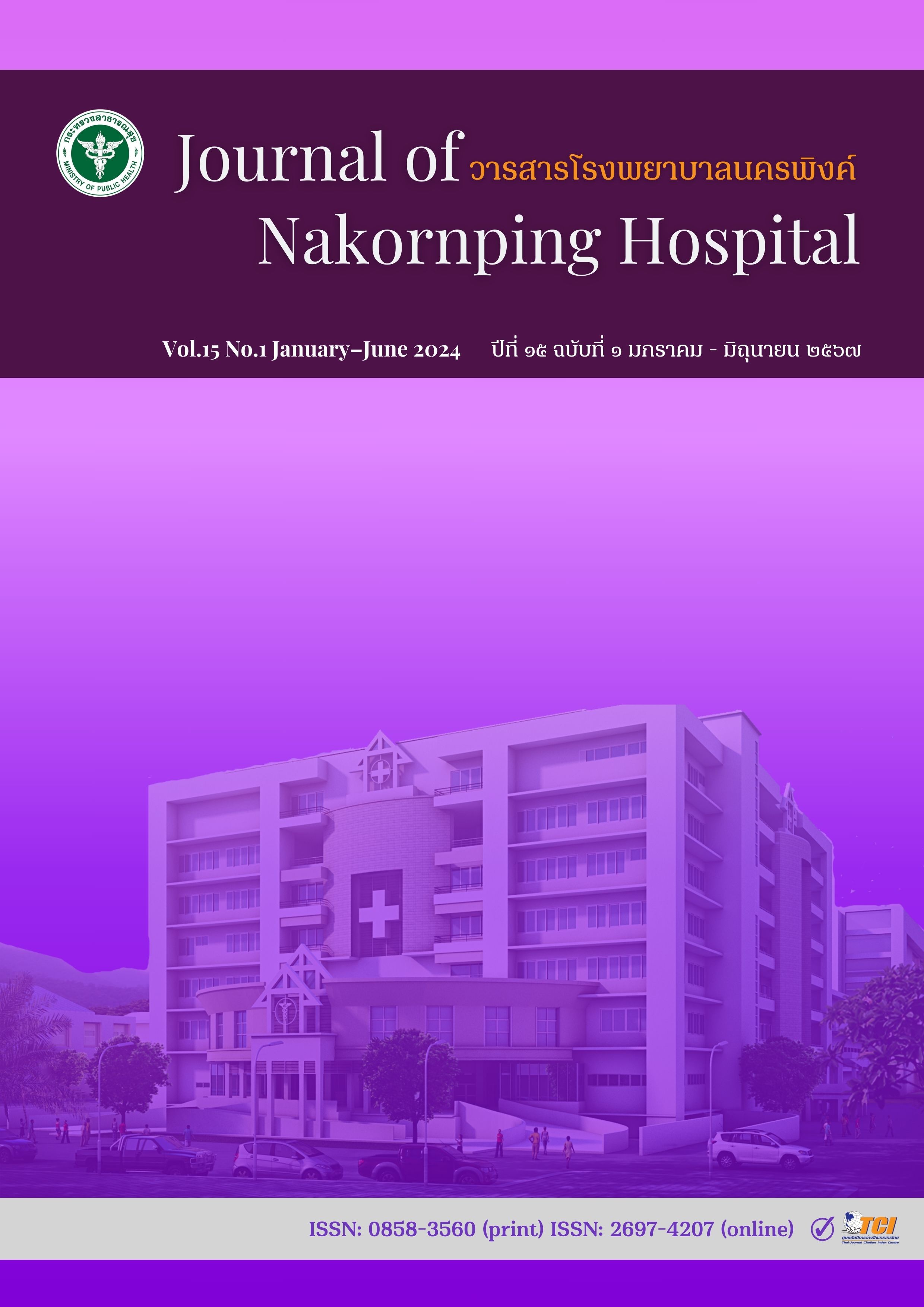Factors associated with the infection among tuberculosis and COVID-19 patients at Nakornping Hospital, Chiangmai Province
Keywords:
tuberculosis patient, Covid-19 patient, CoinfectionAbstract
This research was a retrospective cohort research aimed at investigating the prevalence and factors associated with co-infection of tuberculosis and COVID-19 in tuberculosis patients registered for treatment at Nakornping Hospital in Chiang Mai. The study population consisted of tuberculosis patients who were registered for treatment at the hospital from January 2024 to September 2025, totaling 388 individuals. Data collection involved extracting patient demographic information and co-infection status from the Thai National Tuberculosis Data Reporting System and COVID-19 patient information from the Epid-CM Dashboard. Binary logistic regression analysis was employed to identify factors related to the co-infection of tuberculosis and COVID-19.
Results: The research found that out of the 388 tuberculosis patients, 258 (66.5%) were male, and 130 (33.5%) were female, with an average age of 49.24±17.95 years. Pulmonary tuberculosis was diagnosed in 281 patients (72.4%), while extrapulmonary tuberculosis was diagnosed in 107 patients (27.6%). Co-infection with tuberculosis and COVID-19 was observed in 16 cases (4.12%). Factors significantly associated with co-infection included the type of treatment coverage and patient registration status. Patients covered by social security (Adjusted Odds Ratio 5.17, 95% CI: 1.15-23.38) or government/civil servant healthcare schemes (Adjusted Odds Ratio 6.81, 95% CI: 1.20-38.53) were more likely to be co-infected compared to those with comprehensive health coverage. Additionally, patients who had previously registered as return or retreatment cases after treatment interruption due to medication non-adherence (Adjusted Odds Ratio 7.24, 95% CI: 1.69-30.97) were significantly more prone to co-infection compared to new cases.
Conclusion: Emphasizing knowledge dissemination and self-care guidelines for patients covered by social security, government/civil servant healthcare schemes, and those returning for retreatment after medication interruption may contribute to preventing co-infection of tuberculosis and COVID-19.
References
Bureau of tuberculosis. Guidelines for Prevention and Control of tuberculosis transmission, vol1. Bangkok: Aksorn graphic and design publishing limited partnership; 2016. [In Thai]
World Health Organization. Global Tuberculosis Report 2022 [Internet]. Switzerland: World Health Organization; c2022 [update 2024 Jan 18; cited 2022 Sep 14] Available from: https://www.who.int/teams/global-tuberculosis-programme/tb-reports/global-tuberculosis-report-2022/covid-19-and-tb
World Health Organization. Global tuberculosis report 2019 [Internet]. Switzerland: World Health Organization; c2019. [update 2019 Oct 15; Cited 2024 Feb 9]. Available from: https://www.who.int/publications/i/item/9789241565714
Chiang Mai Provincial Public Health Office. Performance report form Operate according to the government inspection and supervision plan in normal cases, Round 2/2023 Health Zone 1 : Chiang Mai Province [Internet]. [update 2023 Jun 6; cited 2024 Feb 9]. Available from: https://www.chiangmaihealth.go.th/document/230616168691487670.pdf [In Thai]
World Health Organization. Global tuberculosis report 2021 [Internet]. Switzerland: World Health Organization; c2021. [update 2021 Oct 14]. Available from: https://www.who.int/publications/i/item/9789240037021
World Health Organization. COVID-19 Weekly Epidemiological Update [Internet]. Switzerland : World Health Organization; c2021 [update 2021 Feb 23; Cited 2022 Aug 15]. Available from: https://www.who.int/publications/m/item/weekly-epidemiological-update---23-february-2021
Worldometers. COVID-19 Coronavirus pandemic [Internet]. [Cited 2022 Jun 16] Available from: https://www.worldometers.info/coronavirus/
Situation Command Center, Chiang Mai Province (M.P.P). Covid-19 Outbreak in Chiang Mai [Internet]. [Cited 2024 Feb 20]. Available from: https://www.chiangmai.go.th/covid19/assets/img/situation/300464.jpg [In Thai]
Department of Disease Control. Situation of coronavirus disease 2019 (COVID-19) Public health measures and obstacles to disease prevention and control in travelers [Internet]. [update 2021 Aug 8; cited 2024 Feb 7]. Available from: https://ddc.moph.go.th/uploads/files/2017420210820025238.pdf
World Health Organization. Global Tuberculosis Report 2022: COVID-19 and TB [Internet]. Switzerland : World Health Organization; c2022 [update 2024 Jan 18; cited 2022 Sep 14] Available from: https://www.who.int/teams/global-tuberculosis-programme/tb-reports/global-tuberculosis-report-2022/covid-19-and-tb
Song WM, Zhao JY, Zhang QY, Liu SQ, Zhu XH, An QQ, et al. COVID-19 and Tuberculosis Coinfection: An Overview of Case Reports/Case Series and Meta-Analysis. Front Med (Lausanne). 2021;8:657006. doi: 10.3389/fmed.2021.657006.
Wang Q, Guo S, Wei X, Dong Q, Xu N, Li H, et al. Global prevalence, treatment and outcome of tuberculosis and COVID-19 coinfection: a systematic review and meta-analysis (from November 2019 to March 2021). BMJ Open. 2022;12(6):e059396. doi: 10.1136/bmjopen-2021-059396.
Tadolini M, Codecasa LR, García-García JM, Blanc FX, Borisov S, Alffenaar JW, et al. Active tuberculosis, sequelae and COVID-19 co-infection: first cohort of 49 cases. Eur Respir J. 2020;56(1):2001398. doi: 10.1183/13993003.01398-2020.
TB/COVID-19 Global Study Group. Tuberculosis and COVID-19 co-infection: description of the global cohort. Eur Respir J. 2022;59(3):2102538. doi: 10.1183/13993003.02538-2021.
Emergency Public Health Division Office of the Permanent Secretary, Ministry of Public Health. Report on lessons learned from preparation for the 2019 coronavirus outbreak. Health district level [Internet]. c2022 [update 2023 Jan 13, cited. 2024 Feb 24]. Available from: https://mahidol.ac.th/documents/covid19.pdf [In Thai]
Chiang Mai Provincial Public Health Office. Order of the Chiang Mai Communicable Disease Committee [Internet]. [Cited 24 Feb. 2024]. Available from: https://www.chiangmai.go.th/covid19/command.html [In Thai]
Mishra A, George AA, Sahu KK, Lal A, Abraham G. Tuberculosis and COVID-19 Co-infection: An Updated Review. Acta Biomed. 2020;92(1):e2021025. doi: 10.23750/abm.v92i1.10738.
Kumwichar P, Chongsuvivatwong V. COVID-19 pneumonia and the subsequent risk of getting active pulmonary tuberculosis: a population-based dynamic cohort study using national insurance claims databases. EClinicalMedicine. 2023;56:101825. doi: 10.1016/j.eclinm.2023.101825.
Mangamba LE, Sike CIM, Tochie JN, Dalle GN, Nkouagmi N, Balkissou AD, et al. Prevalence of tuberculosis/COVID-19 co-infection and factors associated with SARS-CoV-2 infection in pulmonary tuberculosis patients at a respiratory diseases center: a cross-sectional study. Pan Afr Med J. 2023;44:204. doi: 10.11604/pamj.2023.44.204.38541.
Teerawit P. Pulmonary tuberculosis [Internet]. c2013 [update 2013 Feb 2; cited 2022 Sep 14]. Available from: https://www.rama.mahidol.ac.th/med/sites/default/files/public/pdf/medicinebook1/TB.pdf [In Thai]
Downloads
Published
How to Cite
Issue
Section
License
Copyright (c) 2024 Nakornping Hospital

This work is licensed under a Creative Commons Attribution-NonCommercial-NoDerivatives 4.0 International License.
The articles that had been published in the journal is copyright of Journal of Nakornping hospital, Chiang Mai.
Contents and comments in the articles in Journal of Nakornping hospital are at owner’s responsibilities that editor team may not totally agree with.



